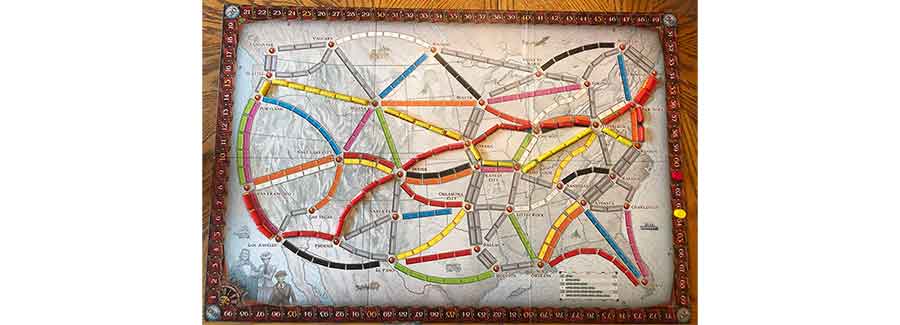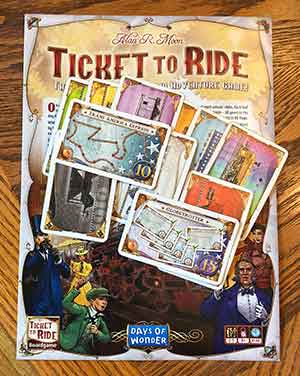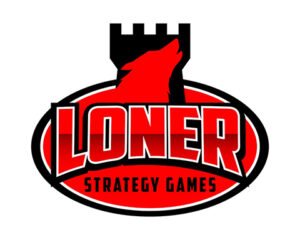
It’s tough to find a game both my wife and I like and both think is fun to play. I’m more of a space game/war game type with deep strategy while she likes the kinds of games that emphasize mental skills, like UpWords. This is a game we both really like and really enjoy.
Ticket To Ride is easy to learn, someone can usually play in less than five minutes after reading the rules. Eight different colored train cards and 14 locomotive (wildcards) in a deck of 110 cards plus 30 destination cards provide countless variations to strategies while not being too complex or deep. This is ideal for casual gaming or a family game night.
The game is quick and easy to set up, the longest amount of time for setup is shuffling the train cards so the sets you turned in from the previous game get separated. It’s a big stack of 110 cards and we often need to split it into two stacks so we can thoroughly shuffle it. To set up a game just give each person a bag of trains, 4 train cards, 3 destination cards, a token to keep score with and then deal five train cards face up and you’re ready to start the game.
The base Ticket To Ride game (there are numerous expansions available) is played on a map of the continental United States. At the start of the game each player gets 4 train cards and 3 destination cards, of which the player must keep at least two.
No two games are alike, and the destination cards dictate your strategy. Depending on whether you get long routes, short routes, routes that can be built together, or routes that have nothing in common determines your strategy, so you can almost never use the same strategy twice. This adds a lot replayability to the game.
Ticket To Ride Is Easy To Learn And Play
This one of the best, most enjoyable board games that can be played by two players. There are even two -player versions for the game (check out my TTR two-player page).
The game is very easy to learn. The rules are printed double-sided on one sheet folded in half like a book, making four pages in all and then most of that is taken up by graphics. The first page is a title page with a large a graphic, so this leaves about three pages of very simple, easy to follow rules. Draw train cards and then build routes to complete your routes between the cities on your destination cards.

Although competitive, it doesn’t usually result in hard feelings unless you block routes on purpose, just to frustrate the other player, but that often backfires and actually causes you to lose the game sometimes.
The game is short, it only takes 30 to 45 minutes to play a game for two experienced players. Of course, depending on a player’s playstyle it can take longer. Sometimes it can take a little thought to look over new destination cards you may have drawn and try to figure out which ones fit the best with your overall strategy.
You’re never really out of the game, although sometimes it seems like it if an important route gets blocked. There are almost always alternate paths available, which can give you more points and possibly result in you winning the game. And you can still score big points (15) by claiming 6 car segments, even if they are not part of any route you may have.
There are enough choices that can be made during your turn to keep you engaged in the game without being overwhelmed. You do one of three things during your turn, draw two more train cards, claim a route, or draw three more destinations cards, of which you only need to keep one. This simplicity does not detract from the enjoyment of the game however, and if you’re looking for something enjoyable that doesn’t take hours to determine a strategy and plan your next move out, this is the game for you.
There is not much “down time” between turns, especially if in a two-player game with an experienced player. This means less time to become distracted and bored, and no time to give in to any phone addictions you may have. There simply isn’t enough time between turns to read phone texts or e-mails.
It’s fun to see how many routes you can combine when adding trains, meaning you can construct more routes by making your limited supply of trains go farther and get more points for less trains. It can give you a real sense of accomplishment and fun, even if you don’t win the game.
There is no trading, combat or transferring of money from one player to another, which means there is no deep strategy to the game. This makes it an ideal family game, especially for families with younger children. There is some suspense in the game which makes it hold your interest. For instance, wondering if you’ve tipped off your planned route when you start claiming route segments is one element of suspense.
Once you start claiming a route you hold your breath. Does the other player feel threatened and take a segment close to yours and block your route? Or maybe they just want to take your segment as a ‘blocking’ tactic, or maybe just out of good old fashioned spite? The fortunate thing is that you can almost never totally block someone from completing their route, only delay them by forcing them to take a longer path.
If you think you’ve made an error in keeping score it’s very easy to correct, just count up the point value of the completed routes on the board and then move the marker to the correct score if needed.
Fun House Rules
One house rule we like to use is that the loser of the last game goes first; otherwise, since the rules say the most experienced traveler should go first, it would always be the same person when my wife and I play. Letting the loser start first at least gives that person a very slight advantage at the start of the game.
Although not a house rule my wife and I frequently like to do a mini recap of the game. It’s fun explaining why you built a route the way you did, and listen to how I unintentionally (?) interfered with her plans for routes.
For example, in one of our games I built a two-car route from Washington to Baltimore, then on the next turn I built a three-car route from San Francisco to Los Angeles, which appeared to make no sense at all to her and interfered with her plans. But since I had destination cards from San Francisco to Washington and another one from Los Angeles to Boston, it made perfect sense to join those two cities together, since after that anything I constructed cross-country built both routes at the same time, a very effective use of my trains.
And luck of the draw sometimes does play an important part in scoring. Toward the end of the game I gambled and drew some more destination cards and just by sheer luck I drew the Phoenix to Boston destination card. By simply building a two-car route from New York to Boston I gained some significant points since the rest of the route was already built.
This is the type of game where you can “play nice” if you want to. My wife and I actually tell each other when we’re about two turns away from going out, although that’s usually obvious by counting how many trains and cards other players have left. Sometimes it can shift the balance of the game and allow the other person to win, but that’s an added challenge that I like. It takes planning to prepare for that ahead of time and actually provides another element of suspense and fun!
You can have a lot of fun just explaining your strategy at the end of the game and how it changed as the game went one. And who knows, you just might pick up a tip or two from your partner’s explanation.
What else is fun? Okay, the kid in me likes to have little trains to play with (our cats like them too). Who doesn’t like trains? And even if you lose it’s still fun and satisfying completing train routes.
If you want some tips on playing the game go to my TTR strategy page.
Dislikes
What do I dislike? If I’m looking for an easy game to play that doesn’t need a lot of in-depth strategy this is the game I go to. With that perspective in mind, there’s really not very much I dislike about this game. Even most of the random luck has been taken out of the game since it doesn’t use dice, although there is still some luck in the destination cards and the train card colors you get. This actually serves as an equalizer for those who are not interested in or experts at making up a strategy for the game and makes it more fun. The biggest concern is having enough room to play since the game board is almost twice the size of a Monopoly board (read about Monopoly here on my website).
Don’t forget to visit my YouTube channel at https://www.youtube.com/channel/UCcWU6qxVisK93h5guKRVtdg
The only other dislike I have is more of due to human nature than a problem with the game. Since the game board is so big you can watch the other players eyes and get an idea of where the routes for that player are. Wear sunglasses!
